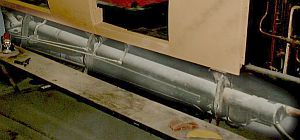
the feed water heater mounted between the two right wheels of the car. it is mounted under the splash guard between the running board and the car body.
The principal task of a boiler is to heat water into steam. In heating water into steam sufficient heat energy must be added to the water to turn it into saturated steam at the operating pressure of the boiler. The early Stanley cars simply drew water from the supply tank and pumped it into the boiler as needed. The steam is then consumed by the engine to do mechanical work and exhausted to the atmosphere.
Beginning with the 1912 model year Stanley added feed water heaters to their cars. The feed water heater not only acts as a muffler for the engine exhaust but it uses some of the heat energy in the exhausted steam to add heat to the water flowing in to the boiler. For non-condensing cars from 1912 through 1914 the feed water heater assembly was mounted in the burner exhaust pipe running to the rear of the car thus taking advantage of the combustion gasses to add additional heat to the water. With the water going into the boiler pre-heated the boiler doesn’t have to work as hard converting it to steam. A Stanley with a feed water heater typically sees a 15% to 20% improvement in economy and performance over the same car with the feed water heater not functional.